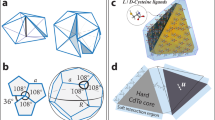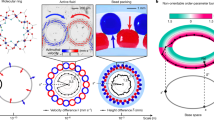Abstract
The solid phases of gold(I) and/or silver(I) cyanides are supramolecular assemblies of inorganic polymer chains in which the key structural degrees of freedom—namely, the relative vertical shifts of neighbouring chains—are mathematically equivalent to the phase angles of rotating planar (‘XY’) spins. Here, we show how the supramolecular interactions between chains can be tuned to mimic different magnetic interactions. In this way, the structures of gold(I) and/or silver(I) cyanides reflect the phase behaviour of triangular XY magnets. Complex magnetic states predicted for this family of magnets—including collective spin-vortices of relevance to data storage applications—are realized in the structural chemistry of these cyanide polymers. Our results demonstrate how chemically simple inorganic materials can behave as structural analogues of otherwise inaccessible ‘toy’ spin models and also how the theoretical understanding of those models allows control over collective (‘emergent’) phenomena in supramolecular systems.
This is a preview of subscription content, access via your institution
Access options
Subscribe to this journal
Receive 12 print issues and online access
$259.00 per year
only $21.58 per issue
Buy this article
- Purchase on Springer Link
- Instant access to full article PDF
Prices may be subject to local taxes which are calculated during checkout



Similar content being viewed by others
References
Nitschke, J. R. Systems chemistry: molecular networks come of age. Nature 462, 736–738 (2009).
Tait, S. L. Surface chemistry: self-assembling Sierpiński triangles. Nature Chem. 7, 370–371 (2015).
Sun, Q.-F. et al. Self-assembled M24L48 polyhedra and their sharp structural switch upon subtle ligand variation. Science 328, 1144–1147 (2010).
Balazs, A. C. & Epstein, I. R. Chemistry. Emergent or just complex? Science 325, 1632–1634 (2009).
Moessner, R. & Ramirez, A. P. Geometrical frustration. Phys. Today 59, 24–29 (2006).
Žukovič, M. & Idogaki, T. Low-temperature long-range ordering of a classical XY spin system with bilinear-biquadratic exchange Hamiltonian. Physica B 329–333, 1055–1056 (2003).
Anderson, P. W. Ordering and antiferromagnetism in ferrites. Phys. Rev. 102, 1008–1013 (1956).
Harris, M. J., Bramwell, S. T., McMorrow, D. F., Zeiske, T. & Godfrey, K. W. Geometrical frustration in the ferromagnetic pyrochlore Ho2Ti2O7 . Phys. Rev. Lett. 79, 2554–2557 (1997).
Bramwell, S. T. & Gingras, M. J. P. Spin ice state in frustrated magnetic pyrochlore materials. Science 294, 1495–1501 (2001).
Pauling, L. The structure and entropy of ice and of other crystals with some randomness of atomic arrangement. J. Am. Chem. Soc. 57, 2680–2684 (1935).
Castelnovo, C., Moessner, R. & Sondhi, S. L. Magnetic monopoles in spin ice. Nature 451, 42–45 (2008).
Lacroix, C., Mendels, P. & Mila, F. Introduction to Frustrated Magnetism (Springer, 2011).
Ludlow, R. F. & Otto, S. Systems chemistry. Chem. Soc. Rev. 37, 101–108 (2008).
Nagaosa, N. & Tokura, Y. Topological properties and dynamics of magnetic skyrmions. Nature Nanotech. 8, 899–911 (2013).
Giblin, S. R., Bramwell, S. T., Holdsworth, P. C. W., Prabhakaran, D. & Terry, I. Creation and measurement of long-lived magnetic monopole currents in spin ice. Nature Phys. 7, 252–258 (2011).
Nakatsuji, S. et al. Spin disorder on a triangular lattice. Science 309, 1697–1700 (2005).
Blunt, M. O. et al. Random tiling and topological defects in a two-dimensional molecular network. Science 322, 1077–1081 (2008).
Adamson, J., Funnell, N. P., Thompson, A. L. & Goodwin, A. L. Structural investigation of a hydrogen bond order–disorder transition in a polar one-dimensional confined ice. Phys. Chem. Chem. Phys. 16, 2654–2659 (2014).
Simonov, A., Weber, T. & Steurer, W. Experimental uncertainties of three-dimensional pair distribution function investigations exemplified on the diffuse scattering from a tris-tert-butyl-1,3,5-benzene tricarboxamide single crystal. J. Appl. Crystallogr. 47, 2011–2018 (2014).
Zeng, X. et al. Complex multicolor tilings and critical phenomena in tetraphilic liquid crystals. Science 331, 1302–1306 (2011).
Shoemaker, D. P. et al. Atomic displacements in the charge ice pyrochlore Bi2Ti2O6O′ studied by neutron total scattering. Phys. Rev. B. 81, 144113 (2010).
Fairbank, V. E., Thompson, A. L., Cooper, R. I. & Goodwin, A. L. Charge-ice dynamics in the negative thermal expansion material Cd(CN)2 . Phys. Rev. B 86, 104113 (2012).
Whitaker, M. J. & Greaves, C. Magnetic ordering in the pyrochlore Ho2CrSbO7 determined from neutron diffraction, and the magnetic properties of other RE2CrSbO7 phases (RE=Y, Tb, Dy, Er). J. Solid State Chem. 215, 171–175 (2014).
Taroni, A. Artificial spin rotors. Nature Mater. 13, 915 (2014).
Hibble, S. J., Cheyne, S. M., Hannon, A. C. & Eversfield, S. G. Beyond Bragg scattering: the structure of AgCN determined from total neutron diffraction. Inorg. Chem. 41, 1042–1044 (2002).
Hibble, S. J., Hannon, A. C. & Cheyne, S. M. Structure of AuCN determined from total neutron diffraction. Inorg. Chem. 42, 4724–4730 (2003).
Chippindale, A. M. et al. Mixed copper, silver, and gold cyanides, (MxM′1–x)CN: tailoring chain structures to influence physical properties. J. Am. Chem. Soc. 134, 16387–16400 (2012).
Sharpe, A. G. The Chemistry of Cyano Complexes of the Transition Metals (Academic, 1976).
Bowmaker, G. A., Kennedy, B. J. & Reid, J. C. Crystal structures of AuCN and AgCN and vibrational spectroscopic studies of AuCN, AgCN, and CuCN. Inorg. Chem. 37, 3968–3974 (1998).
Jansen, M. Homoatomic d10–d10 interactions: their effects on structure and chemical and physical properties. Angew. Chem. Int. Ed. Engl. 26, 1098–1110 (1987).
O'Grady, E. & Kaltsoyannis, N. Does metallophilicity increase or decrease down group 11? Computational investigations of [Cl–M–PH3]2 (M=Cu, Ag, Au, [111]). Phys. Chem. Chem. Phys. 6, 680–687 (2004).
Schmidbaur, H. & Schier, A. Argentophilic interactions. Angew. Chem. Int. Ed. 54, 746–784 (2015).
Pyykkö, P. Theoretical chemistry of gold. Angew. Chem. Int. Ed. 43, 4412–4456 (2004).
Tissier, M., Delmaotte, B. & Mouhanna, D. XY frustrated systems: continuous exponents in discontinuous phase transitions. Phys. Rev. B 67, 134422 (2003).
Okumura, S., Yoshino, H. & Kawamura, H. Spin-chirality decoupling and critical properties of a two-dimensional fully frustrated XY model. Phys. Rev. B 83, 094429 (2011).
Collins, M. F. & Petrenko, O. A. Triangular antiferromagnets. Can. J. Phys. 75, 605–655 (1997).
Keen, D. A. & Goodwin, A. L. The crystallography of correlated disorder. Nature 521, 303–309 (2015).
Laüchli, A., Mila, F. & Penk, K. Quadrupolar phases of the S = 1 bilinear-biquadratic Heisenberg model on the triangular lattice. Phys. Rev. Lett. 97, 087205 (2006).
Qi, K., Qin, M. H., Jia, X. T. & Liu, J.-M. Phase diagram of ferromagnetic XY model with nematic coupling on a triangular lattice. J. Magn. Magn. Mater. 340, 127–130 (2013).
Stoudenmire, E. M. & Trebst, S. & Balents, L. Quadrupolar correlations and spin freezing in S=1 triangular lattice antiferromagnets. Phys. Rev. B 79, 214436 (2009).
Mermin, N. D. & Wagner, H. Absence of ferromagnetism or antiferromagnetism in one- or two-dimensional isotropic Heisenberg models. Phys. Rev. Lett. 17, 1133–1136 (1966).
Kosterlitz, J. M. & Thouless, D. J. Ordering, metastability and phase transitions in two-dimensional systems. J. Phys. C 6, 1181–1203 (1973).
Mühlbauer, S. et al. Skyrmion lattice in a chiral magnet. Science 323, 915–919 (2009).
Falo, F., Floria, L. M. & Navarro, R. Monte Carlo simulations of finite-size effects in Kosterlitz Thouless systems. J. Phys. Condens. Matter 1, 5139–5150 (1989).
Xu, H.-J. & Southern, B. W. Phase transitions in the classical XY antiferromagnet on the triangular lattice. J. Phys. A 29, L133–L139 (1996).
Ran, Y., Zhang, Y. & Vishwanath, A. One-dimensional topologically protected modes in topological insulators with lattice dislocations. Nature Phys. 5, 298–303 (2009).
Coudert, F.-X. Responsive metal–organic frameworks and framework materials: under pressure, taking the heat, in the spotlight, with friends. Chem. Mater. 27, 1905–1916 (2015).
Dovesi, R. et al. CRYSTAL: a computational tool for the ab initio study of the electronic properties of crystals. Z. Krist. 220, 571–573 (2005).
Peintinger, M. F., Oliveira, D. V. & Bredow, T. Consistent Gaussian basis sets of triple-zeta valence with polarization quality for solid-state calculations. J. Comput. Chem. 34, 451–459 (2013).
Doll, K., Pyykkö, P. & Stoll, H. Closed-shell interaction in silver and gold chlorides. J. Chem. Phys. 109, 2339–2345 (1998).
Hay, P. J. & Wadt, W. R. Ab initio effective core potentials for molecular calculations. Potentials for K to Au including the outermost core orbitals. J. Chem. Phys. 82, 299–310 (1985).
Adamo, C. & Barone, V. Toward reliable density functional methods without adjustable parameters: The PBE0 model. J. Chem. Phys. 110, 6158–6170 (1999).
Perdew, J. P. et al. Restoring the density-gradient expansion for exchange in solids and surfaces. Phys. Rev. Lett. 102, 039902 (2009).
Grimme, S. Semiempirical GGA-type density functional constructed with a long-range dispersion correction. J. Comput. Chem. 27, 1787–1799 (2006).
Acknowledgements
A.B.C., M.J.C., J.A.M.P. and A.L.G. acknowledge financial support from the Engineering and Physical Sciences Research Council (EPSRC; EP/G004528/2), the Science and Technology Facilities Council (STFC) and the European Research Council (ERC; grant ref: 279705). High-pressure synchrotron X-ray powder diffraction measurements were carried out at the I15 Beamline, Diamond Light Source, UK. Quantum chemistry calculations made use of high performance computing resources from GENCI (grant x2015087069).
Author information
Authors and Affiliations
Contributions
A.B.C., M.J.C., J.A.M.P., F.-X.C. and A.L.G. conceived and designed the study. A.B.C., D.D. and M.G.T. performed the experiments. A.B.C., M.J.C., J.A.M.P. and A.L.G. interpreted the experimental data. F.-X.C. performed and interpreted the quantum chemistry calculations. A.L.G. wrote the paper. All authors discussed and commented on the manuscript.
Corresponding authors
Ethics declarations
Competing interests
The authors declare no competing financial interests.
Supplementary information
Supplementary information
Supplementary information (PDF 2144 kb)
Rights and permissions
About this article
Cite this article
Cairns, A., Cliffe, M., Paddison, J. et al. Encoding complexity within supramolecular analogues of frustrated magnets. Nature Chem 8, 442–447 (2016). https://doi.org/10.1038/nchem.2462
Received:
Accepted:
Published:
Issue Date:
DOI: https://doi.org/10.1038/nchem.2462
This article is cited by
-
Designing disorder into crystalline materials
Nature Reviews Chemistry (2020)
-
All in a spin
Nature Chemistry (2016)
-
Emergent order in the kagome Ising magnet Dy3Mg2Sb3O14
Nature Communications (2016)



